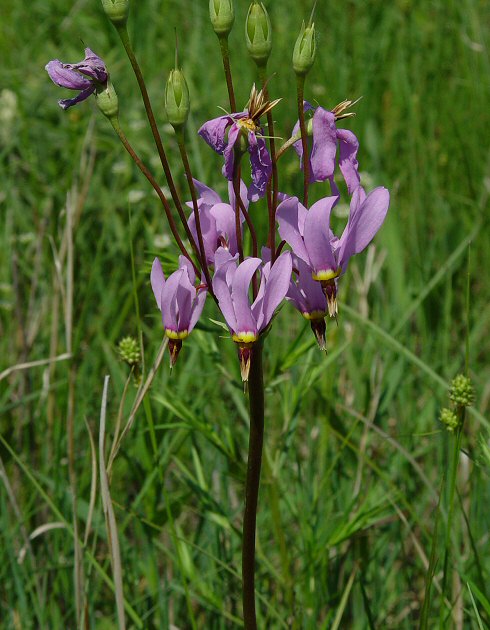Primula meadia (L.) A.R. Mast & Reveal
Common Shooting Star

Native
CC = 7
CW = 3
MOC = 68
© DETenaglia
Primula meadia (L.) A.R. Mast & RevealCommon Shooting Star | |
 |
Native CC = 7 CW = 3 MOC = 68 |
© DETenaglia |
|
Family - Primulaceae Habit - Rhizomatous perennial forb. Stems - Aerial stems absent. Leaves - All basal, 8-26 cm long, the blades oblanceolate or elliptic-oblanceolate, gradually tapered at the base, lacking a distinct petiole, rounded or broadly angled to a blunt point at the tip, the margins entire to inconspicuously scalloped, sometimes slightly wavy, the surfaces glabrous, sometimes with reddish coloration toward the base, especially along the midvein.
Inflorescence - Umbels with 5-20 flowers, the involucral bracts 2-5 mm long, lanceolate, the flower stalks 3-8 cm long, arching in flower, glabrous. Scape to 50 cm, 3 mm in diameter, glabrous. Umbellate cluster terminating scape, with +/-10 flowers.
Flowers - Calyces 5-9 mm long, deeply lobed. Corollas with the tube 2-4 mm long, purple at the throat, the 5 lobes 13-18 mm long, 3-4 mm wide, strongly reflexed, white to pink or lavender, usually yellow at the base, glabrous. Stamens 5, exserted, the filaments free or fused into a membranous tube, the anthers 6-9 mm long, fused into a tube around the style, the bases of their connectives expanded and purple. Ovary green, glabrous, cylindric, to 4 mm long, 2 mm in diameter, with numerous ovules. Placentation free-central. Style 7-10 mm long, slender, the stigma minute, capitate.
Fruits - Ovoid capsules 8-14 mm long, 3-5 mm wide, thick-and hardwalled, dark brown. Seeds 0.6-0.8 mm long, more or less cuboid, angular, brown.
Flowering - April - June. Habitat - Upland forests, prairies, glades, savannas, ledges and tops of bluffs, pastures, fields, roadsides, rock outcrops. Origin - Native to the U.S. Lookalikes - Other species of Primula. Other info. - This striking plant is found throughout most of Missouri except the northwestern corner. Within the continental U.S. its range is largely contained within the Midwest. It is easily recognized by the oddly shaped flowers, though this feature is also shared by the (much rarer) P. frenchii and P. fassettii. The flowers can range from purplish to white but are most commonly pink or pale purple. Photographs taken in Ripley County, MO., 5-15-04 (DETenaglia); also at Valley View Glades Natural Area, 4-28-2010 and 5-8-2017, Young Conservation Area, Jefferson County, MO, 5-2-2013, and at Shaw Nature Reserve, Franklin County, MO, 4-18-2025 (SRTurner). |